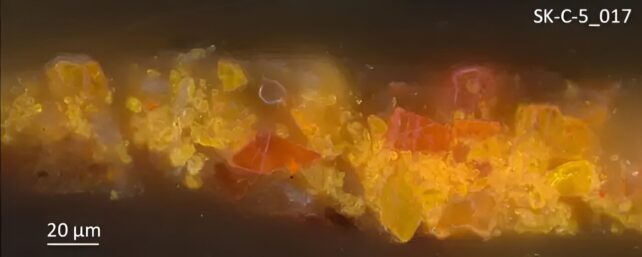The Dutch Golden Age would not have been nearly so golden without Rembrandt's special touch.
Chemists at the Rijksmuseum and the University of Amsterdam have now figured out how the 17th-century Dutch painter, Rembrandt van Rijn, brought glowing light to the scene of The Night Watch.
The secret lies in an unusual combination of paints, including lead-tin yellow and red-orange pigments made with arsenic and sulfur.
It seems that Rembrandt intentionally combined these toxic pigments with other colors to create a golden hue.
The discovery was made as part of a large-scale research and conservation project, named Operation Night Watch, which began in 2019 and which seeks to better understand Rembrandt's masterpiece.
Art historians say that Rembrandt's palette took on "an almost comical level of complexity", but until very recently, little has been known of the colors he mixed for The Night Watch, his most celebrated piece.
In 2017, X-ray imaging of another Rembrandt painting revealed a "whole new pigment" in the Dutch painter's palette: a yellow to orange arsenic-containing dye called artificial orpiment.
The gold from The Night Watch, however, is different.

In the 17th century, some rich pigments were made by adding extra arsenic or sulfur to heated natural arsenic sulfur ores like orpiment or realgar. Some of the paint used to make gold in The Night Watch was derived from yellow, orange, and red pigments of pararealgar.
Researchers used a microscrope to discover that Rembrandt had used small quantities of bright orange paint to highlight the shadows of gold embroidery seen on one militia man's doublet sleeves and embroidered buff coat.
The two arsenic sulfide pigments (red/orange and yellow) were either mixed by Rembrandt to create gold, or they were sold to him in Amsterdam already mixed that way.
A similar pigment mixture observed in another artist from the time suggests the latter scenario may be more realistic.

Altogether, the findings suggest that a wider diversity of toxic pigments were available for use in 17th-century Europe than historians once thought.
"To date, the presence of pararealgar in European paintings and art objects has only been confirmed in a few cases," write the researchers.
Perhaps Rembrandt was on a revolutionary path, or maybe further research on other paintings will reveal he was just one of many 17th-century artists painting with toxic pararealgar pigments.
The study was published in Heritage Science.
